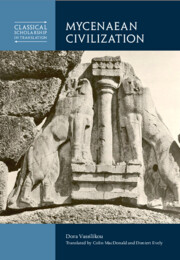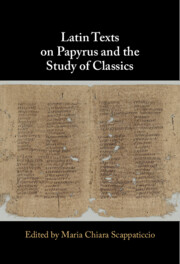Refine search
Actions for selected content:
149391 results in Classical Studies

A Social and Economic History of the Theatre to 300 BC
- Coming soon
-
- Expected online publication date:
- December 2025
- Print publication:
- 31 December 2025
-
- Book
- Export citation

Mycenaean Civilization
- Coming soon
-
- Expected online publication date:
- December 2025
- Print publication:
- 31 December 2025
-
- Book
- Export citation

The Ladder of the Sciences in Late Antique Platonism
- Selected Essays
- Coming soon
-
- Expected online publication date:
- December 2025
- Print publication:
- 31 January 2026
-
- Book
- Export citation

Latin Texts on Papyrus and the Study of Classics
- Coming soon
-
- Expected online publication date:
- December 2025
- Print publication:
- 31 December 2025
-
- Book
- Export citation

The Ancient Scholia to Homer's Iliad
- A Translation
- Coming soon
-
- Expected online publication date:
- December 2025
- Print publication:
- 02 October 2025
-
- Book
- Export citation
5 - Infrastructure and Maintenance Time
- from Part II - Architectural Autobiographies
-
- Book:
- Rebuilding Histories in the Roman World
- Print publication:
- 11 December 2025, pp 207-273
-
- Chapter
- Export citation
6 - The Old and/in the New
- from Part II - Architectural Autobiographies
-
- Book:
- Rebuilding Histories in the Roman World
- Print publication:
- 11 December 2025, pp 274-304
-
- Chapter
- Export citation
Contents
-
- Book:
- Rebuilding Histories in the Roman World
- Print publication:
- 11 December 2025, pp vii-ix
-
- Chapter
- Export citation
3 - Futures Protected?
- from Part I - Patrons and Communities
-
- Book:
- Rebuilding Histories in the Roman World
- Print publication:
- 11 December 2025, pp 122-162
-
- Chapter
- Export citation
Introduction
-
- Book:
- Rebuilding Histories in the Roman World
- Print publication:
- 11 December 2025, pp 1-42
-
- Chapter
- Export citation
Copyright page
-
- Book:
- Rebuilding Histories in the Roman World
- Print publication:
- 11 December 2025, pp iv-iv
-
- Chapter
- Export citation
Acknowledgments
-
- Book:
- Rebuilding Histories in the Roman World
- Print publication:
- 11 December 2025, pp xix-xxiii
-
- Chapter
- Export citation
1 - Virtues of Restoration
- from Part I - Patrons and Communities
-
- Book:
- Rebuilding Histories in the Roman World
- Print publication:
- 11 December 2025, pp 45-86
-
- Chapter
- Export citation
7 - Ornament Revised
- from Part III - “Unmarked” Changes
-
- Book:
- Rebuilding Histories in the Roman World
- Print publication:
- 11 December 2025, pp 307-366
-
- Chapter
- Export citation
Bibliography
-
- Book:
- Rebuilding Histories in the Roman World
- Print publication:
- 11 December 2025, pp 413-500
-
- Chapter
- Export citation

The State, the Law, and the People in the Roman Empire
- A Sourcebook
- Coming soon
-
- Expected online publication date:
- December 2025
- Print publication:
- 11 December 2025
-
- Book
- Export citation
4 - Restorations’ Assembled Records
- from Part II - Architectural Autobiographies
-
- Book:
- Rebuilding Histories in the Roman World
- Print publication:
- 11 December 2025, pp 165-206
-
- Chapter
- Export citation
Dedication
-
- Book:
- Rebuilding Histories in the Roman World
- Print publication:
- 11 December 2025, pp v-vi
-
- Chapter
- Export citation
Tables
-
- Book:
- Rebuilding Histories in the Roman World
- Print publication:
- 11 December 2025, pp xviii-xviii
-
- Chapter
- Export citation
Part III - “Unmarked” Changes
-
- Book:
- Rebuilding Histories in the Roman World
- Print publication:
- 11 December 2025, pp 305-409
-
- Chapter
- Export citation
